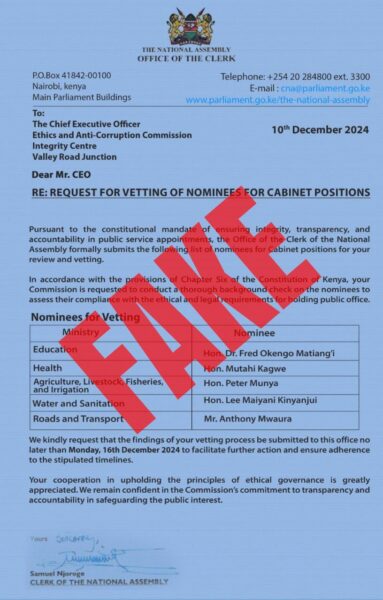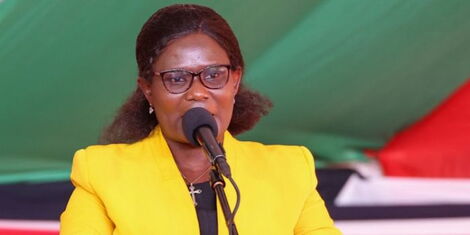A memo purportedly sent by the National Assembly to the Ethics and Anti-Corruption Commission (EACC), requesting a vetting of new Cabinet Secretary nominees, has been dismissed as fake, igniting speculation and controversy. The document, allegedly signed by the Clerk of the National Assembly and dated December 10, listed five individuals for vetting, including three former Cabinet Secretaries from the previous administration.
The memo, now debunked, has raised eyebrows due to its timing and content. It called on the EACC to “conduct a thorough background check on the nominees to assess their compliance with the ethical and legal requirements for holding public office,” a process mandated by Chapter Six of the Constitution. However, the National Assembly has categorically disowned the document, terming it misleading and fraudulent.
The Fake Memo: Fuel for Political Speculation
The emergence of this document has been linked to recent political developments, particularly a high-profile meeting between President William Ruto and retired President Uhuru Kenyatta at the latter’s Gatundu residence. This rare interaction has fueled rumors of a possible political pact that could see allies of the former president included in Ruto’s Cabinet as part of a broader reconciliation strategy.
Adding fuel to the fire, the memo’s release coincided with ongoing discussions around political inclusion and unity. Analysts speculate that the document may have been an attempt to manipulate the narrative surrounding the meeting and to create a wedge between political camps. The coincidence of its timing has led many to question whether its creation was a deliberate political ploy.
State House Response: Emphasizing Unity
In a statement issued on December 9, State House clarified the purpose of the Ruto-Uhuru meeting, asserting that it was centered on matters of national and regional importance. The statement highlighted the need for a harmonious working relationship among Kenyans and reiterated Ruto’s respect for Uhuru’s statesmanship during the peaceful transfer of power after the 2022 elections.
“President Ruto took the opportunity to reiterate his appreciation and commendation of His Excellency President Kenyatta’s statesmanship in overseeing the peaceful transfer of power after the 2022 elections, as well as the goodwill the former President has continued to demonstrate toward his fellow leaders and his support for Kenya’s ongoing progress and development,” the statement read.
Political Chess: Ruto’s Unlikely Alliances
President Ruto’s public statements have also underscored his push for unity among political leaders. Speaking in Wajir, Ruto emphasized the importance of bridge-building, saying, “We want to fashion a country that all of us believe in, a country that we can all have a stake in and participate in it in realizing our full potential.” He highlighted the significance of collaboration with leaders such as Raila Odinga and Uhuru Kenyatta to address Kenya’s challenges.
This marked shift in tone, particularly Ruto’s willingness to work with his former rivals, has led to speculation about a broader political strategy. Ruto’s outreach could be aimed at neutralizing opposition and creating a stable environment for his administration to implement its policies. Critics, however, view it as a calculated move to co-opt adversaries and consolidate power.
Public Reaction: Divided Opinions
The fake memo has further polarized public opinion. Supporters of Ruto see his actions as statesmanlike, a testament to his commitment to fostering national unity. However, skeptics argue that the president’s overtures to former political adversaries, including Raila and Uhuru, may signal behind-the-scenes deals that could compromise his government’s agenda.
The inclusion of three former Cabinet Secretaries in the fake memo has also sparked debate. While some view their potential return to government as a pragmatic move to leverage their experience, others see it as a betrayal of Ruto’s promise to break from the past and usher in a new era of governance.
The Bigger Picture: Unity or Survival?
At the heart of this controversy lies a fundamental question: is Ruto’s outreach a genuine effort to build a united Kenya, or is it a survival strategy in a politically volatile environment? By working with former adversaries, Ruto may be seeking to diffuse political tensions, but he risks alienating his base, which rallied around his anti-establishment message during the 2022 election campaign.
Meanwhile, the fake memo serves as a reminder of the deep mistrust and manipulation that continue to characterize Kenya’s political landscape. Whether it was an act of sabotage or a miscalculated attempt at political gamesmanship, its impact has been to deepen divisions and raise questions about the authenticity of the country’s political reconciliation efforts.
As the dust settles on the fake vetting memo scandal, the spotlight remains on President Ruto’s evolving political strategy. His engagement with Uhuru and Raila reflects a significant shift in Kenya’s political dynamics, but it also raises critical questions about transparency, governance, and the cost of unity. For now, Kenyans can only watch and wait, as the nation navigates a complex web of alliances and rivalries in its quest for progress and stability.






